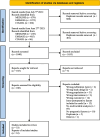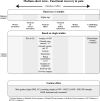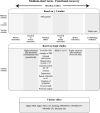Patient-related prognostic factors for function and pain after shoulder arthroplasty: a systematic review
- PMID: 39578927
- PMCID: PMC11583791
- DOI: 10.1186/s13643-024-02694-y
Patient-related prognostic factors for function and pain after shoulder arthroplasty: a systematic review
Abstract
Background: While shared decision making is a cornerstone of orthopedic care, orthopedic surgeons face challenges in tailoring their advice and expectation management to individual shoulder arthroplasty patients due to the lack of systematically summarized evidence-based knowledge. This systematic review aims to provide an overview of current knowledge on independent predictive effects of patient-related factors on functional and pain-related outcomes after shoulder arthroplasty.
Methods: We included longitudinal cohort studies including patients receiving total or reverse shoulder arthroplasty or hemiarthroplasty for primary osteoarthritis or cuff tear arthropathy. Studies with only univariable analyses were excluded. MEDLINE, Embase, and CINAHL databases were last searched on June 27, 2023. Risk of bias was evaluated using the QUIPS tool. For the analyses, we divided outcomes into three domains (Functional Recovery, Pain, and Functional Recovery & Pain) and four time points (short term, medium-short term, medium-long term and long term). When appropriate, meta-analyses were conducted to pool regression coefficients or odds ratios. Otherwise, results were summarized in a qualitative analysis. We used the GRADE approach to rate the certainty of the evidence.
Results: Thirty-three studies analyzing over 6900 patients were included; these studied 16 PROMs and 52 prognostic factors. We could perform meta-analyses for six combinations of prognostic factor, domain, and time point. Only the meta-analysis for medium-long term poor ASES scores indicated worse outcomes for previous shoulder surgery (OR (95%CI) of 2.10 (1.33-3.33)). The majority of reported factors showed unclear or neutral independent effects on functional outcomes.
Conclusions: Methodological heterogeneity and selective/incomplete reporting prevented us from pooling most results, culminating in a largely qualitative analysis. Depression, preoperative opioid use, preoperative ASES and SST scores, surgery on the dominant side, previous surgery, male gender, no. of patient-reported allergies, back pain, living alone, CTA vs OA, diabetes, and greater preoperative external ROM predicted neutral to worse or worse outcomes. In contrast, higher electrical pain threshold on the operative side, OA/RCA vs other diagnosis, and private insurance vs Medicaid/Medicare predicted neutral to better or better outcomes. These results can help orthopedic surgeons tailor their advice and better manage expectations.
Systematic review registration: PROSPERO CRD42021284822.
Keywords: Functional recovery; PROMs; Pain; Prognostic factor; Shoulder arthroplasty.
© 2024. The Author(s).
Conflict of interest statement
Declarations. Ethics approval and consent to participate: Not applicable. Consent for publication: Not applicable. Competing interests: The authors declare that they have no competing interests.
Figures











Similar articles
-
Shoulder replacement surgery for osteoarthritis and rotator cuff tear arthropathy.Cochrane Database Syst Rev. 2020 Apr 21;4(4):CD012879. doi: 10.1002/14651858.CD012879.pub2. Cochrane Database Syst Rev. 2020. PMID: 32315453 Free PMC article.
-
Clinical outcomes of reverse total shoulder arthroplasty for elective indications versus acute 3- and 4-part proximal humeral fractures: a systematic review and meta-analysis.J Shoulder Elbow Surg. 2022 Jan;31(1):e14-e21. doi: 10.1016/j.jse.2021.07.014. Epub 2021 Aug 25. J Shoulder Elbow Surg. 2022. PMID: 34454040
-
Predictors of poor and excellent outcomes after reverse total shoulder arthroplasty.J Shoulder Elbow Surg. 2022 Feb;31(2):294-301. doi: 10.1016/j.jse.2021.07.009. Epub 2021 Aug 16. J Shoulder Elbow Surg. 2022. PMID: 34411725
-
Are Age and Patient Gender Associated With Different Rates and Magnitudes of Clinical Improvement After Reverse Shoulder Arthroplasty?Clin Orthop Relat Res. 2018 Jun;476(6):1264-1273. doi: 10.1007/s11999.0000000000000270. Clin Orthop Relat Res. 2018. PMID: 29601384 Free PMC article.
-
What Change in American Shoulder and Elbow Surgeons Score Represents a Clinically Important Change After Shoulder Arthroplasty?Clin Orthop Relat Res. 2016 Dec;474(12):2672-2681. doi: 10.1007/s11999-016-4968-z. Epub 2016 Jul 8. Clin Orthop Relat Res. 2016. PMID: 27392769 Free PMC article.
Cited by
-
The moderating role of negative affect on pain in patients with rheumatoid arthritis who have undergone shoulder arthroplasty.J Orthop Surg Res. 2025 Jul 21;20(1):686. doi: 10.1186/s13018-025-06109-z. J Orthop Surg Res. 2025. PMID: 40691634 Free PMC article.
References
-
- Wagner ER, Farley KX, Higgins I, Wilson JM, Daly CA, Gottschalk MB. The incidence of shoulder arthroplasty: rise and future projections compared with hip and knee arthroplasty. J Shoulder Elbow Surg. 2020;29(12):2601–9. - PubMed
-
- Wilson CD, Probe RA. Shared decision-making in orthopaedic surgery. J Am Acad Orthop Surg. 2020;28(23):e1032–41. - PubMed
-
- Vajapey SP, Cvetanovich GL, Bishop JY, Neviaser AS. Psychosocial factors affecting outcomes after shoulder arthroplasty: a systematic review. J Shoulder Elbow Surg. 2020;29(5):e175–84. - PubMed
-
- Debray TP, Damen JA, Snell KI, Ensor J, Hooft L, Reitsma JB, et al. A guide to systematic review and meta-analysis of prediction model performance. BMJ. 2017;356:i6460. - PubMed
Publication types
MeSH terms
LinkOut - more resources
Full Text Sources

